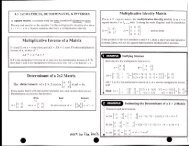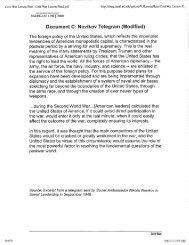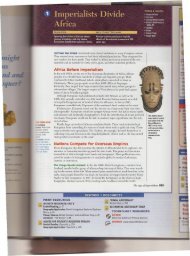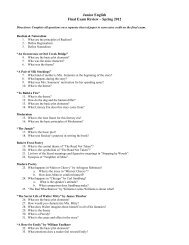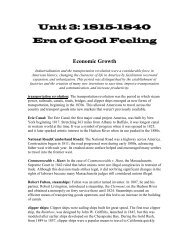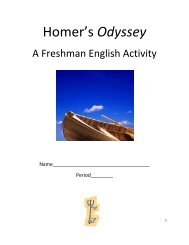The Tide Rises, the Tide Falls
The Tide Rises, the Tide Falls
The Tide Rises, the Tide Falls
You also want an ePaper? Increase the reach of your titles
YUMPU automatically turns print PDFs into web optimized ePapers that Google loves.
<strong>The</strong> <strong>Tide</strong> <strong>Rises</strong>,<br />
<strong>the</strong><br />
<strong>Tide</strong><br />
By Henry Wadsworth Wadsworth Longfellow<br />
Longfellow<br />
Junior English<br />
Mountain Pointe<br />
High School<br />
<strong>Falls</strong>
Introduction<br />
• Tid <strong>Tide</strong> rising i i and d falling f lli = progression i of f life lif<br />
• No man can speed process up or slow it<br />
down<br />
– Just as sun rises and sets<br />
• <strong>Tide</strong>, sun, and time stop for no man…<strong>the</strong>y<br />
go g<br />
on…and on…and on…
Stanza Stanza 1<br />
• Th <strong>The</strong> tide tid rises, i <strong>the</strong> th tide tid f falls, ll A<br />
<strong>The</strong> twilight darkens, <strong>the</strong> curlew calls;<br />
Along <strong>the</strong> sea sea-sands sands damp and brown<br />
<strong>The</strong> traveler hastens toward <strong>the</strong> town, ,<br />
And <strong>the</strong> tide rises, <strong>the</strong> tide falls. A<br />
What is <strong>the</strong> rhyme scheme of this poem?<br />
A<br />
B<br />
B
Stanza 1 1 Analysis<br />
Analysis<br />
• <strong>The</strong>re are places, as Longfellow would have been<br />
aware, where h iti it is only l possible ibl to t cross an inlet i l t at t<br />
low tide<br />
• First stanza<br />
• Traveler is hastening toward <strong>the</strong> town<br />
• To traveler, reason for journey is is: :<br />
– Vitally important<br />
– Worth <strong>the</strong> risk risk of racing <strong>the</strong> tide tide to to reach reach o<strong>the</strong>r side<br />
side<br />
• He loses race and <strong>the</strong> tide reaches traveler<br />
before attaining important goal
Stanza 2<br />
• Darkness settles on roofs and walls,<br />
But <strong>the</strong> sea, sea, <strong>the</strong> sea sea in in darkness darkness calls;<br />
calls;<br />
<strong>The</strong> little waves, with <strong>the</strong>ir soft, white hands<br />
Efface <strong>the</strong> footprints in <strong>the</strong> sands,<br />
sands,<br />
And <strong>the</strong> tide rises, <strong>the</strong> tide falls.<br />
What words are repeated in first two lines? Darkness and Sea<br />
What effect does this have on <strong>the</strong> poem?<br />
It creates t a somber b atmosphere t h<br />
What type of figurative language is being<br />
used here? Personification
• Second stanza:<br />
Stanza 2 2 Analysis<br />
Analysis<br />
– Wh What h happens after f d death h<br />
– Footprints being washed away by waves<br />
symbolizes b li th that t you may b be f forgotten tt after ft<br />
death
• <strong>The</strong>mes<br />
Stanza 2 2 Analysis<br />
Analysis<br />
– Man pitting himself against nature<br />
• Man loses<br />
– <strong>Tide</strong> rises and <strong>the</strong> tide falls<br />
• Nature will will overcome overcome everything everything man man tries tries to to do do to<br />
to<br />
overcome it<br />
– <strong>Tide</strong> will keep p rising g and falling g and traveler is<br />
forgotten
Stanza Stanza 3<br />
<strong>The</strong> <strong>The</strong> morning breaks; <strong>the</strong> steeds in <strong>the</strong>ir stalls<br />
Stamp and neigh, as <strong>the</strong> hostler calls;<br />
<strong>The</strong> day day returns returns, but but nevermore<br />
nevermore<br />
Returns <strong>the</strong> traveler to <strong>the</strong> shore.<br />
And <strong>the</strong> tide rises, rises <strong>the</strong> tide falls falls.<br />
Which Which poetic poetic device device is is being being used used in in <strong>the</strong> <strong>the</strong> first first two two lines?<br />
lines?<br />
Alliteration
• Third Third stanza:<br />
stanza:<br />
Stanza 3 3 Analysis<br />
Analysis<br />
– Symbolizes that life does continue even if you<br />
are not not around to see it<br />
it<br />
• <strong>Tide</strong> will continue to rise and fall just like life will go<br />
on and people may die along <strong>the</strong> way
What is Longfellow trying trying to to tell tell us?<br />
us?<br />
• Longfellow Longfellow paints very bleak picture<br />
– Whatever we do, time and tide will wash away<br />
<strong>the</strong> <strong>the</strong> memory of of ourselves and and our our actions<br />
actions
<strong>The</strong> Message?<br />
Message?<br />
• <strong>The</strong> hostler, with calming calming influence influence and and slow<br />
slow<br />
and steady approach will have more impact<br />
on life and history y than traveler<br />
• <strong>The</strong> one who fights against time and tide tide–<br />
and loses loses–will will be forgotten g long g before <strong>the</strong><br />
o<strong>the</strong>r who moves with <strong>the</strong> tide and accepts<br />
nature for what it is
<strong>The</strong>mes<br />
• <strong>The</strong> tide rising and falling, contrasts, or is just <strong>the</strong> opposite<br />
of f man, i in that h it i is i a constant, like lik time i<br />
– Time marches on<br />
– This is nature<br />
• Man, has a time limit here on earth<br />
– Man will die<br />
– Man can keep p coming g to <strong>the</strong> tide, , for every y day y of his entire<br />
life<br />
• Man will die, but <strong>the</strong> tide will continue to rise and fall,<br />
whe<strong>the</strong>r he is alive to see it, or not<br />
• <strong>The</strong> tide is forever young, while man is forever older<br />
• Man has a time limit, while tide and time have none
• <strong>The</strong>me of death<br />
<strong>The</strong>mes e es<br />
– Using ocean as a symbol of life and <strong>the</strong> town town as a symbol of<br />
death<br />
• Overall progression that <strong>the</strong> stanzas go through:<br />
– First stanza<br />
• Actual death of <strong>the</strong> traveler<br />
– Second stanza<br />
• What happens after is death<br />
– Third stanza<br />
• How life goes g on, even if<br />
someone di dies
Tone<br />
• Tone i is accepting i and calm<br />
• Using words that relate to <strong>the</strong> ocean, which<br />
most people associate with serenity and<br />
tranquility<br />
• Author understands that he is going to die<br />
one day y or ano<strong>the</strong>r<br />
– Something that he cannot avoid
Messages<br />
•<br />
•<br />
General message about<br />
death<br />
Author associates associates darkness<br />
darkness<br />
with death, ocean with life,<br />
and light with heaven<br />
• Indirect message<br />
– People should do all <strong>the</strong>y can<br />
in life<br />
• Once life is gone it will<br />
never come back<br />
• Once a person p reaches<br />
death:<br />
– Legacy can be forgotten<br />
• Go to heaven (or hell)<br />
• N Never return t t to lif life<br />
– Should be all <strong>the</strong>y can be<br />
and dd do nothing thi t to regret t past t<br />
actions<br />
– Death is unavoidable, but<br />
that does not mean it must<br />
b bbe be f feared d<br />
• Rising and falling of <strong>the</strong><br />
tide<br />
– D Death thi is constant t t and d<br />
forever<br />
– People cannot stop death<br />
from coming
To To Sum Sum It Up<br />
• Elements of romanticism:<br />
– Longfellow portrays death as<br />
• A fact of life<br />
• An inevitable occurrence occurrence to to be be accepted<br />
accepted<br />
• Not to be feared<br />
– Symbolic y nature of tides suggest gg that death, , like<br />
ocean, is continual, and forever<br />
• Just as one cannot stop <strong>the</strong> tides of <strong>the</strong> ocean<br />
erasing erasing <strong>the</strong>ir "footprints footprints in <strong>the</strong> sands" sands , or<br />
ra<strong>the</strong>r <strong>the</strong>ir existence in <strong>the</strong> world, one<br />
cannot stop death from claiming his/her life
Work Cited<br />
Cited<br />
• Longfellow, g , Henry y Wadsworth. “<strong>The</strong> <strong>Tide</strong> <strong>Rises</strong>, , <strong>the</strong> <strong>Tide</strong><br />
<strong>Falls</strong>.” Elite Skills Classic 2007. Google.com. 05<br />
November 2007 < . >.



